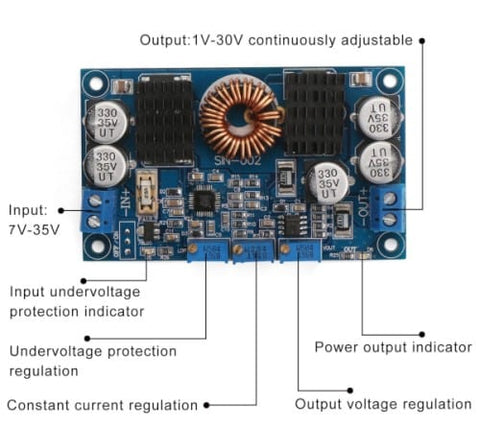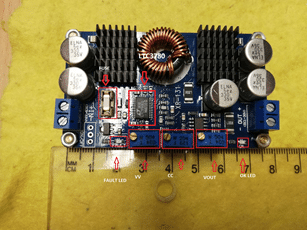Buck-Boost power modules have many applications, from solar power to driving LED’s at a constant current.
It has lots of functions but number one is to supply a preset voltage, no matter if the voltage received is higher or lower than the supplied voltage.
If you set the voltage, as an example to 12V, it will keep the voltage constant even if it receives more or less than 12 V. It thus boosts voltage that is under the set voltage and decreases the voltage if it is above the set voltage.
You can, as an example, connect this unit directly to a 12V water pump, set the voltage to 12V and it will constantly drive this pump at that voltage. Even if the solar panel output voltage falls below the 12V or go higher than 12V.

How to use this solar charger module. Written by Stepan Vosloo.
I recently got the chance to use the Solar charger module / step-up step-down power module. The heart of this module is the LT 3780EG IC from Linear Technologies, so, there is a lot of technical info about this module, to say the least.
I will spare you all the reading and get straight to the point with this module. What is a Buck converter? Well, it can step down your voltage, eg. 12VDC to 4.20VDC (For those Li-ion batteries) What is a boost converter? Well, it can step up your voltage, eg. 7VDC to 12VDC. This module does both, from 1VDC to 30VDC (mine was 29.92VDC), I tested with a 13.87VDC 12A fully regulated power supply. At first, I didn’t expect too much of this little module, to give you an idea of how small it is, here a few pictures. The standoffs are not included.
If you look at the top picture, the pots are as follows:
Left-hand side potentiometer is used to adjust the Under Voltage Protection (VV) function. What does this mean? The device can monitor a DC-DC output voltage, and disconnect the power source from the DC-DC input load when an overvoltage condition occurs. A power-OK (Green) output signals when the DC-DC input voltage falls below an adjustable threshold. It is mostly used for solar charging.
The middle pot is Constant Current (CC), what does this mean? A constant current does not change its intensity over time, so it will stay constantly the same.
The right-hand side pot is Voltage Output (VOUT), what does mean? This is the pot that changes your output voltage from 1V to 30V……I got mine down to 0.8V. If you are not familiar with the Multiturn Trimpot Resistor, aka trim pot, get yourself a precision screwdriver that fits just perfect, I’ve had a few mishaps with thinking the screwdriver fits right, well, it doesn’t end well for your pocket or your voltage controller……
How much power can it handle, and how efficient is it, you ask?
Well, I powered a 5W LED light from a single 3.7V Li-ion battery, without it even breaking a sweat…. I actually nearly blew it, because I pushed the voltage to just over 15V, but decided to bring it down after my son complained that the light was too bright Next up, was my 8W USB soldering iron…. according to the datasheets of these USB soldering irons, it requires just 1A at 5V, I normally use a 2A cell phone charger for this….it just works better, it heats up faster. Speaking of heating up faster, 15 seconds they claim for the USB soldering iron to be hot (450°C), with the LTC3780, you can expect reduced time to around 5-8 seconds! Yes, I kid you not. Soldering was more responsive, and quicker…..it heated up faster, when I soldered something with some weight like 24 AWG wires, not 1 or 2, about 10. I got bored pretty quickly though, as I kept the best for last
Pushing its limits.
My TEC1-12708 12V 72W cold plate. Now, if you are not familiar with TEC units, they draw an immense amount of power. This particular bad boy draws a whopping 8.5A @ 12V, but on average it draws 6-8A, if you keep the voltage below the maximum threshold, which is 15.4V. I DO NOT RECOMMEND YOU USE IT AT THESE VOLTAGES! I have 4, so I am willing to put 1 at risk for testing purposes. I hooked it up to my W1209 thermostat, connected to a TEC cooler box, I needed to cool down a beer ASAP, just kidding, am I? anyway, temps came down to 2 °C, this was 15H00 in the afternoon. The LTC3780 had a little bit of trouble pushing a 72W TEC at 12V, the heatsinks actually heated up, now from what I understand, they almost never heat up. I have to add, I deliberately used a 3A 12V regulated DC PSU for this, I wanted to see the LTC3780 was capable of doing.
It really surprised me, and already have a few ideas in mind for an adjustable bench PSU. Sweet spot for efficiency is 98% at 12V @ 5A. All in all, well worth your money, most definitely. I use it for just about everything now.
Reset the pots.
All pots can be reset to default by turning them anti-clockwise, for about 15 turns, the unit doesn’t need to be on, same for output voltage…. can be done without the unit being on. Do not get a fright when the FAULT LED is on when you switch on the unit, just adjust the pot clockwise, until the OK LED (Green) comes on…. this you will need to do whenever you change the input voltage.
Conclusion.
What else can I say, go and buy one! Now….it will replace all your LM2956, XL4015 , PWM’s etc…. this module is really an all in one wonder, I LOVE IT.
Solar charger module / step-up step-down module